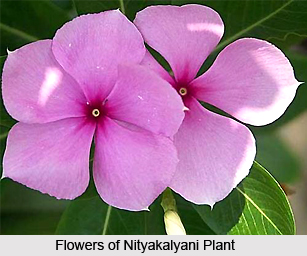Nityakalyani is an Indian medicinal plant that has the botanical name of Lochnera rosea. This plant is commonly known as `Nayantara` in West Bengal, `Barmasi` in Gujarat, Rrattanjot` in Punjab, `Nityakalyani` in Sanskrit and `Sudukadu` in Tamil Nadu
 The plant of Nityakalyani is an erect, much branched, an annual or perennial herb and grows up to 30 centimetres to 90 centimetres. The leaves are oblong-elliptic, glossy, with a slightly fetid odour. The base is acute and apex rounded. The flowers of this plant are fragrant, white to pinkish-purple in colour. The fruits are slender and hairy. The fruit contains many seeds and are 2 centimetres to 3 centimetres long. The seeds are oblong, minute and black. The flowers and fruits generally grow throughout the year, but they grow in abundance mostly during the rainy season.
The plant of Nityakalyani is an erect, much branched, an annual or perennial herb and grows up to 30 centimetres to 90 centimetres. The leaves are oblong-elliptic, glossy, with a slightly fetid odour. The base is acute and apex rounded. The flowers of this plant are fragrant, white to pinkish-purple in colour. The fruits are slender and hairy. The fruit contains many seeds and are 2 centimetres to 3 centimetres long. The seeds are oblong, minute and black. The flowers and fruits generally grow throughout the year, but they grow in abundance mostly during the rainy season.
All parts of the plant Nityakalyani are rich in alkaloids, with maximum concentrations found in the root bark, particularly during flowering. The vinblastine, vincristine, leurosi-dine and leurosine are oncolytic alkaloids of proven value are used vastly for the treatment of various cancers. Apart from healing cancer, this plant is used for curing Hodgkin`s disease, lymphosarcoma, choriocarcinoma, neuroblastoma, carcinoma of the breast, lungs and other organs as well as acute and chronic leukaemia. Even the root of the plant contains fractions of alkaloids and chloroform. These alkaloids and chloroform have significant hypotensive, sedative and tranquillizing properties. An infusion of the leaves is used to treat hypermenorrhoea. The juice of the leaves of Nayantara is applied externally to relieve wasp stings. All parts of the plant are credited with hypoglycaemic properties. This plant Nayantara is also used as therapeutic for diabetes.
This article is a stub. You can enrich it by adding more information to it. Send your write up at contentindianetzone.com











